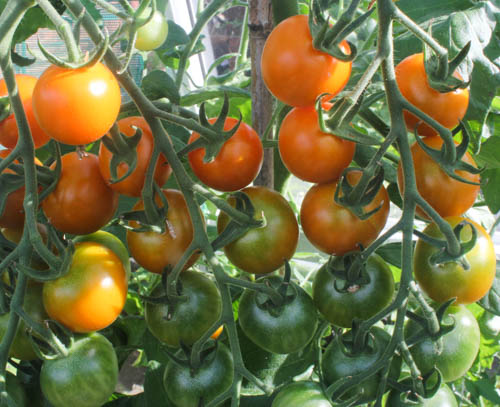
Aubergines and tomatoes that have finished cropping, as some of mine have, can be composted, creating more space in the greenhouse border and between pots on the bench, admitting more sunlight and improving air circulation around the plants that remain. Early in the month, remove individual leaves around aubergines, peppers and cucumbers and continue feeding with high potash fertiliser to encourage ripening.
The space that becomes available as the bench is cleared can be used to sow oriental and winter vegetables in modules for transplanting, buying extra growing time in glasshouses which are too small to direct sow. Oriental vegetables, like Pak Choi, Mizuna, Mibuna greens, komatsuna and other winter hardy vegetables like ‘Lamb’s Lettuce’, round beetroot for leaves, radish for leaves and roots, chard, coriander, peas for shoots, rocket, sorrel, spinach and turnip are all tasty options. Choose your favourites according to your space; spacing in and between rows can be considerably reduced as plants grow less rapidly.
Later in the month, trusses of unripe tomatoes can be removed from the plant and ripened under cloches, greenhouse benches or a warm sunny windowsill, and winter crops planted in their place. Alternatively, strip most of the leaves from tomatoes and peppers, encouraging the remaining fruit to ripen.
There is still time to take cuttings of tender plants to overwinter in the greenhouse. Bay, rosemary, sage, osteospermums and other tender plants, fuchsias and shrubs propagate freely from tip or semi-ripe cuttings. To take semi-ripe cuttings, remove young healthy shoots from this year’s growth from 2.5-3” long, trim them just below a leaf joint with a sharp pair of secateurs or knife. Using your finger and thumb, strip off the leaves from the bottom 1” of the cutting, dip the bottom 1” in hormone rooting powder, tapping lightly to remove any excess. Fill a 3.5” pot with cutting compost, firm it gently then insert the cuttings round the edge so the leaves of adjacent cuttings do not touch then firm the compost again. Water thoroughly allow to drain, then put the pot in a propagator or put a central cane in the pot and cover with a clear plastic bag and put a rubber band over the end, then put on a sunny windowsill. Cuttings take two months to root at the most, keep the compost moist but not waterlogged and ‘air’ the cuttings occasionally to prevent fungal infections.
Towards the end of the month, remove the glasshouse shading. It is also a good opportunity to tidy, clean and disinfect the glasshouse while the weather is still warm.
Water or damp down the greenhouse during the morning to reduce the chance of botrytis or grey mould, which thrives in a still, damp, atmosphere and reduce ventilation when temperatures drop later in the month.
September is the ideal month for treating vine weevil with biological control. You should also eradicate pests and diseases from tender plants before bringing them into the greenhouse over winter.
Happy gardening, Matt.


